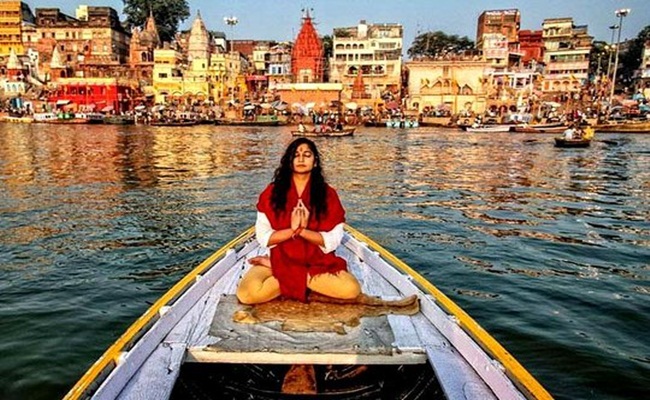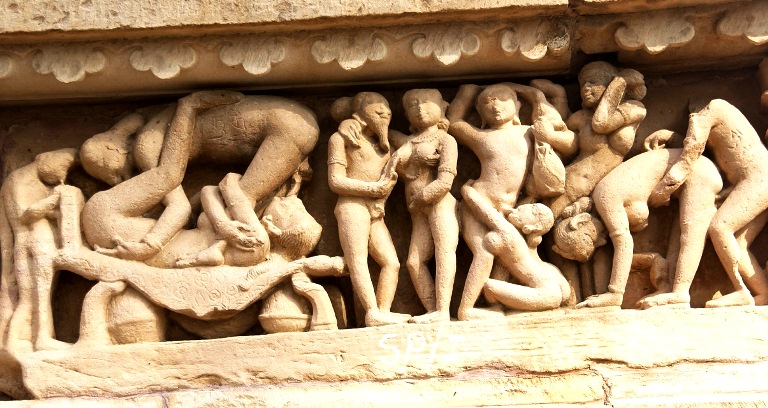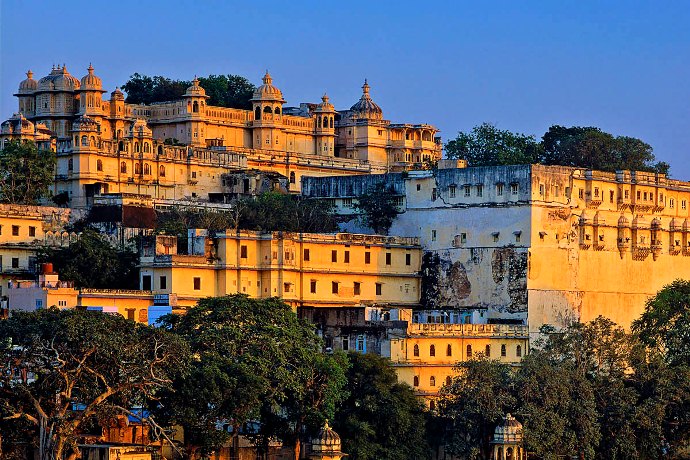
RAJASTHAN- The state of Rajasthan is associated with the astounding legends of heroism and romance still echoes from its royal fort and palaces that stands majestically on hilltop to narrate the tale of a chivalry and audacity. The magic of vibrant Rajasthan - its rich heritage, colorful culture, exciting desert safaris, shining sand-dunes, amazing variety lush forests and varied wildlife - makes it a destination nonpareil. Rajasthan is often portrayed as one vast open-air museum, with its relics so well preserved that it delights even the most skeptical traveler. Rajasthan India comprises of forts and palaces, wildlife. All this makes Rajasthan a wonderful destination to explore. Travel Rajasthan in order to explore the exquisite craftsmanship of bygone era. Tourism in Rajasthan makes state one of the most visited state of India.
VARANASI- It is one of the oldest living cities in the world. It probably derives from the two rivers that flank the city, the Varuna to the north and the Asi to the south. Many still use the anglicized forms of Banaras or Benares, while pilgrims refer to Kashi. The city of Banaras is situated on the west bank of the holiest of all Indian rivers, the Ganga or Ganges. The relationship between the sacred river and the city is the essence of Varanasi - 'the land of sacred light'.
KHAJURAHO- It is a city well known for its temples and sculptures. The exuberance of Indian spirit represents a paean to life, love, to joy-perfect in execution and sublime in expression. The Khajuraho temples are internationally famous for the erotic sculptures that adorn the walls.
ORCHHA- The meaning of the place, Orchha is a hidden place and it perfectly justifies this small village hidden by the forests. Its grandeur has been captured in stone, frozen in time a rich legacy to the ages. It is a major tourist attraction of Madhya Pradesh because of the number of beautifully built palaces, temples and cenotaphs built in the 16th and 17th centuries reflecting the rich Bundela art and architecture.
AGRA- The Land of culture and heritage. Agra is the city of the inimitable Taj Mahal. Agra is famous for its marble inlay work, leather goods, brasswares, finely worked precious and semi-precious stone jewelry and ornate zari embroidery.
FATEHPUR SIKRI- Once the capital of the Mughal emperor Akbar, a deserted, red sandstone city built by the Mughal Emperor Akbar in the 16th century. It is built in red sandstone, and is a beautiful blend of Hindu and Islamic architectural elements.
JAIPUR- Jaipur is remarkable for its marvelous architecture and town planning as it is for the lively spirit of the people who inhabit it. The city presents a unique synthesis of culture that has to be experienced in order to be appreciated. The old Jaipur painted in Pink, the lively spirit of fanfare, festivity and celebration of the people adequately match the colorful and intricately carved monuments.
JODHPUR- Popularly called the Blue City of Rajasthan- Jodhpur is second largest city in Rajasthan after Jaipur. It is an island of marble palaces from the desert by an immense wall, with eight gates facing different directions. Jodhpur is famous for its magnificent fort and palaces. The city is situated at the edge of the Thar Desert with Jaisalmer on its west, Bikaner on its north side.
UDAIPUR- One of the most beautiful cities of Rajasthan, located on the banks of Lake Pichola, also known as a 'Jewel of Mewar'. The most romantic city of India can take the tourist into paroxysm of heaven. The center of attraction vibrates around the shimmering blue waters and the royal white marble palaces constructed with unique artistic insight.
PUSHKAR- Located 11km from Ajmer, according to Hindu mythology the town is the creation of Lord Brahma - the Creator of the Universe. A temple dedicated to Brahma has been built here. Pushkar also hosts one of the most colorful cattle fairs in the country. A very important pilgrimage spot for Hindus, Pushkar is famous for its lake.
DELHI- New Delhi, capital of India is a mix of the ancient and modern architecture. This 3rd largest city of India unwinds a picture rich with culture, architecture, and human diversity. Divided in two parts, Old Delhi & New Delhi, the city is a travel hub of Northern India and exerts a beguiling charm on visitors.
Tour Destination: Delhi - Varanasi (by flight) - Khajuraho - Orchha - Agra - Fatehpur Sikri - Jaipur - Jodhpur - Udaipur - Pushkar - Delhi
Travel Duration: 12 Nights/13 Days
DAY 1: DELHI - VARANASI (BY FLIGHT)
Welcome at New Delhi International Airport. On arrival, wait for your next flight to Varanasi. Arrival at Varanasi Airport where our vehicle will be waiting for you.
Transfer to your hotel. Overnight at Hotel.
DAY 2: VARANASI
After breakfast visit, early morning boat cruise at the river Ganges to observe the way of life of pilgrims by the Ghats. The Ganga Ghats are the main centre of religious activities and rituals and also form one of the main attractions of Varanasi. The Alamgir Mosque, blend of Hindu and Mughal styles of architecture, is another important attraction of Varanasi.
Some of the important temples are Durga Temple, Vishwanath Temple, Sankat Mochan Temple, Tlsi Manas Temple and The Bharat Mata Temple. Other attractions of Varanasi are the Benaras Hindu Universality, the Archeological Museuwm and Buddhist Stupas. Evening view Aarti ceremony on the Ghats.
Overnight at Hotel.
DAY 3: VARANASI - KHAJURAHO
Early morning excursion to Sarnath, 10kms. east of Varanasi, is one of the Buddhism pilgrimage centers of India. Post attaining enlightenment, Buddha came to Sarnath where he gave his first sermon. Later drive to Khajuraho, a unique thousand-year-old heritage temple complex in Madhya Pradesh.
Overnight at Hotel.
DAY 4: KHAJURAHO
After breakfast, visit Khajuraho viewing
KHAJURAHO GROUP OF TEMPLES- These temples are known for their Nagara architectural style and are listed as UNSESCO World Heritage Sites. Dating back to 950 AD, the temples are inscribed with ornamental carvings, mostly erotic. Kandariya Mahadev Temple being the best of them all. The temples promoted integrity and acceptance between the Jains and Hindus.
Overnight at Hotel.DAY 5: KHAJURAHO - ORCHHA
CHHATRIS- The cluster of the Chhatris along the Kanchana Ghat of the Betwa River is one of the imposing and attractive features in Orchha. These Chhatris are the memorials of the rulers of Orchha.
ORCHHA FORT- The Fort Complex is the main attraction of Orchha, it is located on an island on the Betwa River.
Later continue your drive to Agra. On reaching transfer to the hotel.
Overnight at Hotel.
DAY 6: AGRA - FATHEPUR SIKRI - JAIPUR
In the morning, take on a city tour of Agra.
TAJ MAHAL- It is the most beautiful monument in Agra. The beauty and grandeur of the Taj Mahal has made it one of the Seven Wonders of the World. Built by Shah Jahan in memory of his wife-Mumtaz Mahal, the Taj Mahal is regarded as one of the most beautiful monuments in the world, symbol of love and beauty.
AGRA FORT- Built in red sandstone, this huge fortress on the bank of the Yamuna. The fort house has many beautiful palaces and mansions, which include Jahangiri Mahal, Khass Mahal, Diwan-i-Khass and Diwan-i-Aam
ITMAD-UD-DUALA TOMB- Also known as Baby Taj, this tomb is a daughter's tribute to her father. Built in 1628 by Nurjahan in memory of her father Mirza Ghiyas Beg.
SIKANDRA FORT- it is 4 kms from Agra where Akbar built his mausoleum. Post lunch, continue your drive to Fathepur Sikri.
FATHEPUR SIKRI- Once the capital of the Mughal emperor Akbar, a deserted, red sandstone city built by the Mughal Emperor Akbar in the 16th century.
Further drive to the Pink city of Rajasthan- Jaipur. Transfer to the hotel.
Overnight at Hotel.
DAY 7: JAIPUR
After breakfast visit the Pink City.
HAWA MAHAL- one of the most common and popular tourist attractions in Jaipur. This five-story building was used as a veil by the royal women folk to watch the proceedings on the road below.
CITY PALACE- In the heart of the old city is former royal residence built in a blend of the Rajasthani and Mughal styles. The palace also has an art gallery with an excellent collection of miniature paintings, carpets, royal paraphernalia and rare astronomical works in Arabic, Persian, Latin and Sanskrit, acquired by Sawai Jai Singh II to study astronomy in detail.
JANTAR MANTAR- A stone observatory, largest of Jai Singh five remarkable observatories. The observatory was built to study the movement of stars. The observatory is built in stone and marble.
AMER PALACE- A beautiful complex of palaces, halls, pavilions, gardens and temples built by Raja Man Singh. Tourists often ride on the elephant back to the Singh pool and the Jaleb Chowk. Other tourist attractions are Jaigarh Fort, Nahargarh Fort, Govind Deoji Mandir, Rambagh Palace, Kanak Valley and Laxmi Narayan Temple.
In the evening you can visit CHOWKI DHANI- well-recreated Rajasthani village. You get an evening entertainment and rich traditional dinner. You can view Rajasthani dances, potters, cooks, go on animal rides, and visit palm readers etc. Return back to Jaipur and overnight at hotel.
DAY 8: JAIPUR - JODHPUR
Next morning drive to the Blue City of Rajasthan- Jodhpur. On reaching, transfer to the hotel. Later visit the city
UMAID BHAWAN PALACE- Maharaja Umaid Singh, a perfect example of early modern period architecture, constructed Umaid Bhawan Palace. Umaid Bhawan palace forms the grandest private royal houses of the world. Some portion of this grand palace has been converted into a luxurious hotel and a museum.
JASWANT THADA- It lies quite close to the Mehrangarh Fort complex. It was built in 1899 AD in the memory of Maharaja Jaswant Singh II and houses the cenotaphs of a number of Rajput royals. The main cenotaph has rare portraits of many Rajput rulers on display.
ARCHITECTURAL SPLENDOR OF JODHPUR- Given the rough terrain it is not surprising that the architecture of the city was influenced by it. Desert architecture is noted for two distinct traits, the need to guard against the heat and to fortify itself against invasions. Fortifications tend to merge with the color of the land, providing it with a natural camouflage.
THE MEHRANGARH FORT- Fort at Jodhpur is such that the fort walls and the sheer basalt escarpment are not distinguishable, one from the other. Huge gates at the entrance are fitted with iron nails to prevent elephants from bringing them down. The palaces and the mansions within the complex are more delicately designed. The chief palaces you can see in the fort are the Phool Mahal, the Moti Mahal, the Jhanki Mahal, the Sheesh Mahal and the Sadar Vilas.
Overnight at Hotel.
DAY 9: JODHPUR - UDAIPUR
Next morning on the drive towards Udaipur en route visit Ranakpur.
RANAKPUR TEMPLE- Temple is acclaimed world-wide for their intricate and superb architectural style. These temples form one of the five major pilgrimages of the Jains. Its 500 years old temples are unique in their style & design, with no other place in Rajasthan having the same ambience and setting as that of Ranakpur. Continue your drive to Udaipur. In the evening enjoy the boat ride on the picturesque Lake Pichola.
DAY 10: UDAIPUR
CITY PALACE- The largest palace of Rajasthan, it represents the architectural and artistic evolution of Mewar over the centuries. The palace is divided into various sections, each with its own distinctive style.
SAHELIYON KI BARI- This garden was the picnic spot for the 48 royal ladies who were offered to the prince as dowry. The gardens here have lush green lawns & beautiful fountains in the shape of birds - presenting a wonderful sight!
JAGDISH TEMPLE- One of the largest and popular Vishnu Temples of Northern India, this temple has exquisite carvings and four other smaller shrines dedicated to other deities.
AHAR- An ancient capital of Mewar, Ahar is the favorite haunt of archaeologists and research scholars. It houses various famous monuments and temples like the Royal Cenotaphs, Adinath Temple, and Mahavira Temple.
Overnight at Hotel.
DAY 11: UDAIPUR - PUSHKAR
Drive to the holy city of Pushkar.
It is a well-known Hindu pilgrim center. The main feature of Pushkar is its lake, which according to Hindu legend was created from a lotus flower dropped by Lord Brahma. and the Brahma temple. Pushkar is better known for the cattle fair.
DAY 12: PUSHKAR - DELHI
RAJ GHAT- A simple open platform inscribed with the Mahatma's last words, 'Hey Ram' (Oh God) is set in a garden with fountains and a variety of exotic trees.
JAMA MASJID- A magnificent historical creation by Shah Jahan. Composed of marble and sandstone it is one of the largest mosques in India. It also contains a few relics of Prophet Muhammad.
Overnight at Hotel.
DAY 13: DELHI:- After breakfast visit New Delhi viewing
INDIA GATE- Built as a memorial to commemorate the 70,000 India soldiers killed in World War I, India Gate was designed by Sir Edwin Lutyens and completed in 1931. The green, velvety lawns at India Gate, particularly, are a popular evening and holiday rendezvous for young and old alike.
PRESIDENT - HOUSE- New Delhi, centers around the Rashtrapati Bhawan. It is architecturally a very impressive building standing at a height, flowing down as it were to India Gate.
HUMAYUN TOMB- The emperor grieving widow, Haji Begum, built Humayun Tomb the first mature example of Mughal architecture in India, in 1565 AD.
LAXMI NARAYAN TEMPLE- Also called the Birla Mandir it was built in 1938; the temple is an ideal introduction to some of the gods of the India pantheon.
LOTUS TEMPLE- The Bahai Temple, is shaped like a lotus. It is an eye-catching edifice worth exploring. Built by the Bahai community, it offers the visitor a serenity that pervades the temple and its artistic design.
QUTAB MINAR- It is among the tallest and famous towers in the world. Qutab-Minar is famed as the highest brick minaret of the world, located amidst the lush greens of South Delhi. In the evening departure at airport/station to move towards onward destination.
Rajasthan at a Glance
- Capital City: Jaipur
- Population: 68,548,437
- Area: 342,239 sq km
- Geo Location: North West
- Average Climate: 10°C to 45°C
- Best time to visit: November - March
Varanasi at a Glance
- Population: 3,676,841
- Area: 1,535 sq km
- Geo Location: North
- Average Climate: 5°C - 20°C
- Best Time to Visit: October - March
- STD Code: 0542
- Airport: Lal Bahadur Shastri International Airport
Khajuraho at a Glance
- Population: 1,762,857
- Area :
- Geo Location: Central
- Average Climate: 4°C - 35°C
- Best Time to Visit: October - March
- STD Code: 07686
- Airport: Khajuraho Airport
Agra at a Glance
- Population: 17, 75,134
- Area: 1,880.40 sq km
- Geo Location: North
- Average Climate: 1°C - 32°C
- Best Time to Visit: October - March
- STD Code: 0562
Jaipur at a Glance
- Population: 6,663,971
- Area: 14,068 sq km
- Geo Location: North West
- Average Climate: 4°C - 30°C
- Best Time to Visit: September - March
- STD Code: 0141
- Airport: Sanganer Airport
Jodhpur at a Glance
- Population: 3,685,681
- Area: 22,850 sq km
- Geo Location: North West
- Average Climate: 7°C - 43°C
- Best Time to Visit: October - March
- STD Code: 02931
- Airport: Jodhpur Airport
Udaipur at a Glance
- Population: 3,067,549
- Area: 13,883 sq km
- Geo Location: North West
- Average Climate: 3°C - 32°C
- Best Time to Visit: September - March
- STD Code: 0294
- Airport: Maharana Pratap Airport
Pushkar at a Glance
- Population: 14,789
- Area: N.A
- Geo Location: North West
- Average Climate: 8°C - 25°C
- Best Time to Visit: October - March
- STD Code: 014581
New Delhi at a Glance
- Population: 16,787,941
- Area: 1,484 sq km
- Geo Location: North
- Average Climate: Summer extends from Apr. to Jun. (25°C to 46°C), Winter from Oct. to Mar. (3°C to 30°C), and Monsoon from Jul. to Sep. (25°C to 35°C).
- Best Time to Visit: Throughout the year, though the best climate is experienced from Sep. to Apr.
- STD Code: 011
- Airport: Indira Gandhi International Airport
Need Aspark Help?
For Tour Packages, Vehicle Rental and Customer Care Support.
+91 9999 31 7846
booking@asparkholidays.comWhy Travel with Us?

Excellent Support
Our Team Available 24x7 for Customer support
Best Price & Savings
We Offer the Most Competitive Prices.


